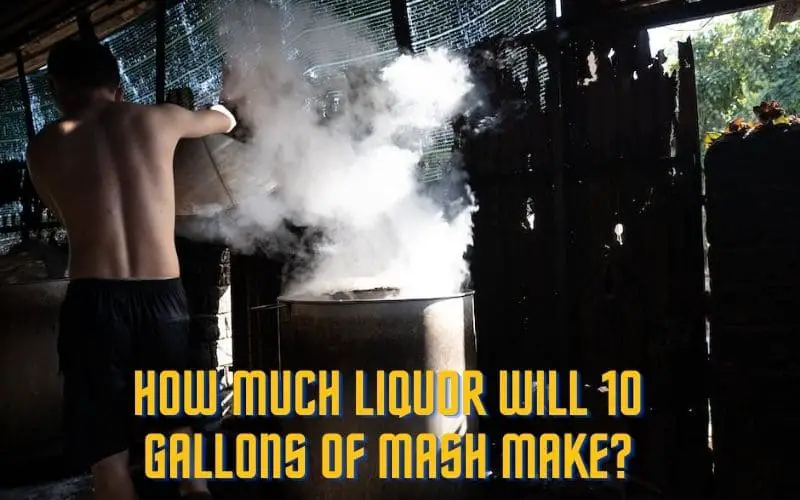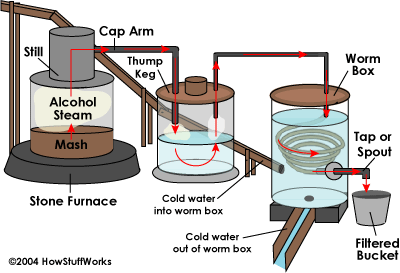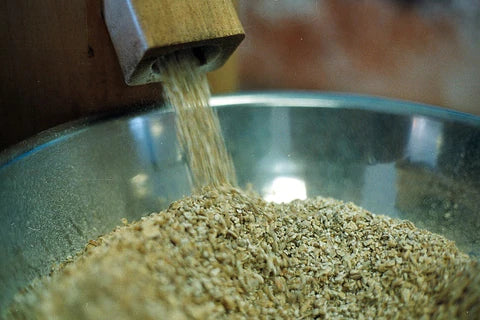10-Gallon Mash Yield Guide: How Much Liquor Will It Produce?

Article-At-A-Glance
- A 10-gallon mash typically yields between 1-2 gallons of finished spirits, depending on your recipe, equipment, and process
- Your fermentation efficiency greatly impacts yield – expect to extract only 75-85% of theoretical alcohol from grains
- Making proper cuts (removing foreshots, heads and tails) reduces yield but is essential for quality and safety
- The simple yield formula: (Volume × ABV% × Distillation Efficiency) ÷ Final Proof = Expected Yield
- Still N The Clear’s ingredient kits are specifically formulated to maximize both yield and flavor for consistent results
One of the most common questions from new distillers is surprisingly simple: “How much whiskey will I actually get from my mash?” When you’ve put in the work to create a 10-gallon mash, it’s natural to wonder about the final reward. The answer involves more science than guesswork, and understanding your expected yield helps you plan better and avoid disappointment.
What You’ll Actually Get From a 10-Gallon Mash

“10 Gallon Mash Tun – Oak Barrel Winecraft” from oakbarrel.com and used with no modifications.
The short answer: from a typical 10-gallon grain mash, you can realistically expect to collect between 1-2 gallons of finished spirits after making proper cuts. This assumes your mash fermented to around 8-10% ABV and you’re collecting at a reasonable proof. Many new distillers are initially disappointed by this seemingly low return, but this is the reality of the concentration process that creates quality spirits.
The Real Numbers: 1-2 Gallons of Final Spirit
For a well-executed 10-gallon corn mash that reaches 9% ABV, you’ll have approximately 0.9 gallons of pure alcohol (10 gallons × 9%). When distilled in a pot still, you’ll likely capture about 80% of that alcohol, giving you about 0.72 gallons of pure alcohol. At 80 proof (40% ABV), this translates to roughly 1.8 gallons of finished product after making proper cuts. With a reflux still, you might achieve higher extraction efficiency but will sacrifice some flavor compounds in the process. The key takeaway here is that distillation concentrates rather than creates – your yield depends primarily on how much alcohol was present in your original mash.
Factors That Affect Your Yield
Several critical factors determine your actual yield, and understanding them helps you set realistic expectations. Your recipe composition (grain bill vs. sugar wash) significantly impacts fermentable sugars available for conversion. Equipment selection matters tremendously – pot stills typically yield less volume at lower proof than reflux stills. Fermentation efficiency varies with yeast strain, nutrient availability, and temperature management. Making proper cuts (removing foreshots, heads, and tails) reduces yield but is non-negotiable for quality and safety. Finally, your collection proof and final dilution decisions directly affect bottle count. Knowing when to stop distilling is crucial for optimizing these factors for consistent, predictable yields.
How Alcohol Yield Works in Home Distilling

“How Moonshine Works – Walton’s Distillery” from www.waltonsdistillery.com and used with no modifications.
Distillation is fundamentally a concentration process, not a creation process. You’re not making alcohol during distillation – you’re separating and concentrating the alcohol already created during fermentation. This means your maximum possible yield is determined before you even fire up your still. For more on understanding the distillation process, check out when to stop distilling.
ABV Basics: Understanding Your Starting Point
Your mash’s alcohol by volume (ABV) percentage is the foundation of all yield calculations. Most grain mashes ferment to approximately 8-10% ABV, while sugar washes can reach 12-20% depending on yeast tolerance. This percentage tells you exactly how much pure alcohol exists in your fermented wash. For example, a 10-gallon mash at 10% ABV contains exactly 1 gallon of pure alcohol (10 × 0.10 = 1). This pure alcohol measurement, sometimes called LAA (Liters of Absolute Alcohol) in commercial settings, represents your theoretical maximum yield before any losses occur during distillation.
The Science Behind Fermentation Efficiency
Grain mashes typically don’t achieve 100% conversion of available sugars to alcohol. Several factors influence your fermentation efficiency, including mash thickness, grain crush quality, mashing temperature profile, and enzyme activity. Most home distillers achieve 75-85% efficiency with all-grain mashes, meaning only that percentage of potential sugars actually converts to alcohol. Sugar washes, by comparison, can achieve nearly 100% fermentation efficiency because all sugars are immediately available to yeast. This efficiency difference is why many commercial distillers add some sugar to their grain mashes – it boosts yield without significantly compromising flavor when done in moderation.
Why You’ll Never Get 100% of the Alcohol Out
Even with perfect fermentation, you’ll never extract all of the alcohol from your mash during distillation. Physics simply won’t allow it. As you distill, the concentration of alcohol in your still gradually decreases, making it increasingly difficult to separate alcohol from water. Commercial distilleries using sophisticated equipment might achieve 95% extraction efficiency, but most home distillers using pot stills typically capture between 70-85% of the theoretical alcohol. The remaining alcohol stays behind in your stillage (spent mash) and is essentially lost. This is why commercial operations often redistill their heads and tails – to maximize extraction of every possible drop of valuable alcohol.
Calculating Your Expected Yield

“Yields and Run Times In Your Still …” from www.youtube.com and used with no modifications.
Understanding how to calculate your expected yield gives you realistic expectations and helps troubleshoot problems. While the math isn’t complex, it does require accounting for several variables unique to your setup and process.
The Simple Formula That Works Every Time
Here’s a reliable formula that will give you a reasonable estimate of your final yield: (Mash Volume × ABV% × Distillation Efficiency) ÷ Final Proof = Expected Yield. For example, if you have 10 gallons of mash at 10% ABV, using a pot still with 80% efficiency, and you’re aiming for 80 proof (40% ABV) spirits, your calculation would be: (10 × 0.10 × 0.80) ÷ 0.40 = 2 gallons. This formula accounts for all the major variables in a home distillation setup. Remember to adjust based on your cuts – if you’re discarding 25% as heads and tails, your actual yield drops to about 1.5 gallons of finished product. For more insights on distillation, you might want to check out when to stop distilling.
Example: Breaking Down a 10-Gallon Sugar Wash
Sugar washes typically achieve higher ABV during fermentation, often reaching 15-18% with specialized yeasts. Let’s calculate the yield from a 10-gallon sugar wash at 15% ABV. With 10 gallons at 15% ABV, you have 1.5 gallons of pure alcohol present after fermentation. Using a pot still with 80% efficiency, you’ll collect about 1.2 gallons of pure alcohol (1.5 × 0.80). At 80 proof (40% ABV), this gives you approximately 3 gallons of finished product before cuts (1.2 ÷ 0.40). After discarding about 30% as heads and tails, you’ll end up with roughly 2.1 gallons of quality spirits. This higher yield illustrates why sugar washes are popular for neutral spirits where flavor complexity is less important.
Example: Breaking Down a 10-Gallon Grain Mash
Grain mashes typically ferment to lower ABV but produce more complex, flavorful spirits. For a 10-gallon corn/barley mash that ferments to 9% ABV, you start with 0.9 gallons of pure alcohol. With 80% still efficiency, you’ll collect about 0.72 gallons of pure alcohol. At 80 proof, this translates to 1.8 gallons before cuts. After removing approximately 30% as heads and tails, you’ll have about 1.26 gallons of quality whiskey. While this yield is lower than a sugar wash, the resulting spirit has significantly more character and complexity, making it the preferred approach for whiskey, bourbon, and other aged spirits.
Ingredients and Their Impact on Yield
%20(2).png)
“Ingredient Yield …” from www.getmeez.com and used with no modifications.
Your ingredient choices dramatically impact not just the flavor of your spirits but also your final yield. Understanding these relationships helps you make informed decisions about recipe formulation based on your priorities – whether maximizing output or creating distinctive flavors.
Sugar vs. Grain: Which Gives Better Returns?
Sugar-based mashes consistently outperform grain mashes in pure yield terms. A 10-gallon sugar wash can easily ferment to 15-20% ABV, potentially yielding 2-3 gallons of finished spirits. In contrast, an all-grain mash might only reach 8-10% ABV, yielding 1-1.5 gallons. This yield difference explains why commercial neutral spirits often start with sugar or molasses. However, grains provide complexity and mouthfeel that sugar simply cannot match. Most craft distillers accept the lower yield from grain mashes as a necessary trade-off for quality and character. Many practical distillers split the difference by using a grain base enhanced with some sugar – capturing better yields while maintaining substantial flavor complexity.
How Yeast Selection Changes Your Final Numbers
Yeast strain selection significantly impacts both your final ABV and, consequently, your yield. Standard brewing yeasts typically tolerate alcohol up to 10-12% ABV before becoming inhibited. Specialized distiller’s yeasts, like Turbo or DADY (Distiller’s Active Dry Yeast), can push fermentation to 15-20% ABV or even higher. This alcohol tolerance difference can increase your final spirit yield by 30-50% when using the same ingredient base. Beyond alcohol tolerance, different yeasts also vary in their efficiency at converting sugars and in the flavor compounds they produce during fermentation. Still N The Clear’s distiller’s yeast is specifically selected to balance high alcohol tolerance with desirable flavor development, maximizing both yield and quality. For more insights on different types of alcohol, check out this guide on alcohol types.
Water-to-Grain Ratios That Maximize Output
The ratio of water to grains in your mash directly affects fermentation efficiency and your final yield. A mash that’s too thick restricts enzyme activity and yeast movement, reducing conversion efficiency. Conversely, a mash that’s too thin dilutes enzyme concentration and can lead to longer fermentation times. For most grain mashes, a ratio of 2-3 quarts of water per pound of grain strikes the ideal balance. For a 10-gallon mash with 9 pounds of grain (the standard ratio for a whiskey mash), you’d use approximately 5-7 gallons of water during mashing, then dilute to 10 gallons total volume before fermentation. This optimized ratio ensures maximum sugar conversion while maintaining appropriate conditions for yeast performance.
Equipment Factors That Affect Your Yield

“How to Make Moonshine: Easy Step-by …” from homebrewacademy.com and used with no modifications.
Your still design significantly impacts both the quantity and quality of your final product. Different still types create different compromises between efficiency, flavor retention, and purity.
Pot Still vs. Reflux: The Big Difference in Output
Pot stills typically deliver spirits at 40-60% ABV (80-120 proof) in a single run, capturing approximately 70-80% of available alcohol. They excel at preserving flavor compounds but sacrifice some efficiency. Reflux stills, with their additional rectification surfaces, can achieve 90-95% alcohol (180-190 proof) and extract up to 90% of available alcohol. This higher efficiency comes at the cost of flavor complexity, as many congeners are removed during increased rectification. A good compromise for many home distillers is a pot still with an optional reflux component that can be engaged or bypassed depending on the desired spirit. For flavor-forward spirits like whiskey and rum, most distillers accept the lower yield of a pot still as a worthwhile trade-off for character.
How Collection Methods Impact Quality and Quantity
Your collection technique dramatically affects both yield and quality. Collecting too fast can reduce separation efficiency and alcohol concentration, while collecting too slowly may extend your run time unnecessarily. Most distillers aim for a collection rate between 1-3 tablespoons per minute for optimal separation. Temperature management also affects collection efficiency – inconsistent heat can cause fluctuating proof and make proper cuts challenging. Digital thermometers and careful control of your heat source improve consistency and maximize your yield of high-quality spirits. Collecting into multiple small jars rather than one large container enables precise control over cuts, allowing you to maximize the hearts portion without compromising quality.
Making the Cuts: Quality vs. Quantity

“How to make Moonshine cuts the way you …” from www.youtube.com and used with no modifications.
Making proper cuts is where art meets science in distillation. Your decisions during this critical phase directly impact both the quantity and quality of your final product.
Foreshots, Heads, Hearts, and Tails Explained
Foreshots (the first 5% of your theoretical yield) contain methanol and other toxic compounds and must always be discarded. Heads (roughly the next 25-30% of your run) contain acetone, acetaldehyde, and other volatile compounds that cause harsh flavors and hangovers. Hearts (the middle 30-40% of your run) represent the cleanest, purest portion of your distillate and form the core of your finished product. Tails (the final 30-35%) contain fusel oils, fatty acids, and water-soluble compounds that can add complexity in small amounts but become unpleasant in excess. By understanding these fractions and learning to identify them by smell, taste, and feel, you’ll maximize the quality portion of your yield while eliminating harmful or unpleasant components.
Why Tossing Some Product Actually Makes Better Spirits
Discarding portions of your run feels counterintuitive when you’re focused on yield, but it’s absolutely essential for quality and safety. Commercial distilleries often capture more of their run than craft distillers, but they compensate with extensive filtering, aging, and blending processes. As a home distiller, your best approach is to be conservative with your cuts, especially when you’re learning. The hearts portion alone gives you a clean, smooth product without requiring extensive additional processing. Remember that the goal isn’t maximum volume, but maximum enjoyment of your final product. A smaller amount of excellent spirits is always preferable to a larger volume of mediocre or potentially harmful product.
Expected Yields After Making Proper Cuts
After accounting for typical cuts, your actual yield of quality spirits from a 10-gallon mash will be significantly less than the theoretical maximum. From a grain mash that ferments to 9% ABV, expect approximately 0.9-1.2 gallons of high-quality finished product at 80 proof after making proper cuts. From a sugar wash at 15% ABV, you might achieve 1.5-2 gallons of finished product. These numbers assume you’re being reasonably conservative with your cuts, which is recommended especially for beginners. As you gain experience, you may fine-tune your cut points to slightly increase yield without compromising quality. Some distillers save their heads and tails for redistillation or blending in future batches, eventually recovering more of the alcohol while maintaining quality standards.
Proof and Dilution: Your Final Volume

“Spirit Dilution Calculator – DIY Distilling” from diydistilling.com and used with no modifications.
The proof at which you bottle your spirits dramatically affects your final yield. Understanding this relationship helps you make informed decisions about your production goals.
The Relationship Between Proof and Yield
The mathematical relationship between proof and yield is straightforward: lower proof equals higher volume. If you collect 1 gallon of 160 proof (80% ABV) spirits from your still, diluting to 80 proof (40% ABV) exactly doubles your yield to 2 gallons. This explains why commercial distilleries often prefer to bottle at the minimum legal proof – it maximizes their yield per batch. Craft distillers frequently choose higher proofs to showcase flavor intensity, accepting lower volume as a trade-off. When planning your production, consider that every 20-point reduction in proof increases your final volume by approximately 25%. This calculation helps you decide whether to prioritize bottle count or flavor concentration.
Diluting to Drinking Strength: How Much Water to Add
Diluting your distillate requires precision to achieve consistent results. The formula for calculating dilution is: Final Volume = (Starting Proof ÷ Target Proof) × Starting Volume. For example, to dilute 1 gallon of 120 proof spirit to 80 proof, you would calculate: (120 ÷ 80) × 1 = 1.5 gallons, meaning you need to add 0.5 gallons (64 ounces) of water. Always use filtered or distilled water for dilution to avoid introducing contaminants. Add water gradually while mixing and measuring, as the process generates heat and volume isn’t perfectly additive due to molecular interactions. For best results, dilute in stages and let the spirit rest between additions to fully integrate and develop its character.
Troubleshooting Low Yields

“Why Is My Moonshine Low Proof (13 …” from diydistilling.com and used with no modifications.
If your yield falls significantly below expectations, several common issues might be responsible. Identifying these problems helps improve future batches and maximize your return on ingredients and effort. For a deeper dive into maximizing your yield, you might find this discussion on yield helpful.
The most common yield issues stem from fermentation problems. Incomplete fermentation leaves unprocessed sugars in your mash, reducing potential alcohol content. Check your final gravity with a hydrometer – if it hasn’t dropped to near its theoretical minimum, your fermentation stalled. Other common yield killers include poor temperature control during distillation, equipment leaks, and improper collection techniques that result in alcohol loss.
Common Mistakes That Reduce Your Output
Several common errors dramatically reduce yield. Insufficient mixing during mashing prevents complete conversion of starches to fermentable sugars. Improper mashing temperatures can denature enzymes before conversion is complete. Using expired or improperly stored yeast reduces fermentation vigor and efficiency. Fermenting at inappropriate temperatures stresses yeast and leads to stalled fermentation. Collecting distillate at too high a proof leaves significant alcohol behind in your still. Excessive temperature fluctuations during distillation cause inconsistent separation and reduced collection efficiency.
Equipment issues also play a major role in reduced yields. Poor condenser performance leads to vapor loss through inefficient condensation. Leaks in your still, especially around connection points, allow alcohol vapor to escape. Inadequate insulation increases heat loss and reduces efficiency. Addressing these common issues can significantly improve your yield without changing your basic recipe or process.
How to Improve Your Yield in Future Batches
Several techniques can boost your yield without compromising quality. Adding amylase enzymes to grain mashes improves starch conversion, especially for high-adjunct recipes. Using a yeast nutrient blend promotes complete fermentation by providing essential micronutrients. Implementing temperature control during fermentation keeps yeast working optimally throughout the process. Checking and maintaining proper pH (5.2-5.5) creates an ideal environment for both enzymes and yeast. For maximum efficiency, consider a double distillation approach – run your wash quickly through a stripping run, then carefully redistill for final collection, which can increase total alcohol capture by 5-10%. Still N The Clear’s ingredient kits include optimized enzyme and nutrient packages specifically designed to maximize fermentation efficiency and yield. For more inspiration, check out this pear moonshine mash recipe to explore different mash techniques.
Get the Most From Your Mash

“Basic Moonshine Mash Recipe” from www.whiskeystillpro.com and used with no modifications.
Maximizing your yield from a 10-gallon mash comes down to attention to detail throughout the entire process. Start with quality ingredients properly proportioned for your target spirit. Manage your mash and fermentation temperatures carefully to optimize enzyme and yeast activity. Maintain your equipment to prevent leaks and inefficiencies. Make appropriate cuts based on your specific goals and spirit type. And perhaps most importantly, keep detailed records of each batch to track improvements over time. While a 10-gallon mash might yield only 1-2 gallons of finished product, understanding the science behind this conversion helps set realistic expectations and appreciate the concentration of flavor and effort in every drop. For consistent results batch after batch, consider Still N The Clear’s carefully formulated ingredient kits that take the guesswork out of mash preparation and maximize your yield.
Frequently Asked Questions
These common questions address specific concerns about mash yield and how to improve your results with each batch.
Is 1 gallon of liquor from a 10-gallon mash a good yield?
Yes, 1 gallon of quality finished spirits from a 10-gallon grain mash represents a good yield for home distilling. This approximates a 10% conversion rate, which aligns with expected efficiency when making proper cuts. Commercial distilleries might achieve slightly higher yields through more efficient equipment and processes, but often at the expense of character and flavor complexity.
If you’re consistently getting less than 0.8 gallons from a 10-gallon grain mash, you likely have opportunities for improvement in your process. If you’re getting significantly more than 1.2 gallons, you might be including too many heads and tails in your final product, potentially compromising quality.
Can I increase my yield without sacrificing quality?
Yes, several techniques can improve yield while maintaining quality: optimizing mash pH (5.2-5.5), using fresh high-quality yeast with proper nutrients, ensuring complete starch conversion through proper mashing techniques, controlling fermentation temperature to match your yeast’s requirements, and eliminating equipment leaks or inefficiencies. The most significant gains usually come from improving fermentation efficiency rather than adjusting your cuts, as proper cuts remain essential for quality and safety. To learn more about the history and techniques, explore moonshine history.
How much does temperature affect fermentation yield?
Temperature dramatically impacts fermentation yield. Most distiller’s yeasts perform optimally between 75-85°F (24-29°C). Fermenting below this range slows yeast activity and can lead to stalled fermentation. Temperatures above this range increase stress on yeast cells, potentially causing off-flavors and premature death. Temperature fluctuations are particularly problematic, as they force yeast to constantly adapt rather than focus on alcohol production. Maintaining steady temperature throughout fermentation can improve alcohol yield by 10-15% compared to uncontrolled conditions.
Do different grains produce significantly different yields?
Yes, grain selection significantly impacts yield. Malted barley contains naturally occurring enzymes that convert its own starches and those of other grains into fermentable sugars, making it highly efficient. Corn provides high starch content (approximately 70-75%) at low cost, offering excellent yield potential when properly converted. Wheat and rye contain less starch (about 60-65%) but contribute distinctive flavors. Unmalted grains require additional enzymes or inclusion of malted barley to achieve complete conversion. For more information on grain yields, you can check out this discussion on grain yield.
For maximum yield, many distillers use a base of corn (70-80%) with enough malted barley (20-30%) to provide necessary enzymes. This combination optimizes cost, conversion efficiency, and fermentability while still developing desirable flavor complexity. Still N The Clear’s ingredient kits use optimized grain bills specifically designed to balance yield and flavor.
Should I collect tails to increase my yield?
Collecting some portion of the tails can increase yield, but requires careful management. The early tails contain valuable flavor compounds alongside less desirable elements. Many experienced distillers collect tails separately and selectively add small amounts back to their hearts to enhance complexity without introducing off-flavors. Another approach is saving tails for redistillation in future batches, effectively reclaiming their alcohol content while removing unwanted compounds. As a general guideline, collect tails until the proof drops below 40-50 proof (20-25% ABV), then decide how to use them based on your quality standards and style preferences. For more insights, learn when to stop distilling to achieve the best results.
- Early tails (80-60 proof) often contain valuable flavor compounds worth saving
- Middle tails (60-40 proof) may be worth collecting for redistillation
- Late tails (below 40 proof) generally contain too little alcohol to justify collection
- Never add tails directly to your final product without careful evaluation
- When in doubt, be conservative – quality always trumps quantity
Understanding mash yield helps set realistic expectations for your home distilling projects. While the 10-15% conversion rate from mash to finished spirits might initially seem low, it reflects the concentration of flavor and character that makes craft spirits special. Each step from grain selection through fermentation, distillation, and final proofing presents opportunities to optimize your process.
Remember that consistency comes from careful measurement, temperature control, and detailed record-keeping. Document your process and results for each batch, noting changes and improvements over time. This methodical approach leads to predictable yields and allows you to make intentional adjustments to both quantity and quality. For those interested in experimenting with different flavors, consider trying a pear moonshine mash recipe to see how variations can impact your results.
As you gain experience, you’ll develop an intuitive feel for your equipment and ingredients, allowing you to make real-time decisions that maximize both yield and quality. The ultimate goal isn’t simply producing more liquid, but crafting spirits that showcase your skill and attention to detail in every drop. For those interested in learning more about maximizing yield, this discussion on yield might be helpful.
For consistent results and maximum yield from your 10-gallon mashes, Still N The Clear offers complete ingredient kits with precisely measured components and detailed instructions tailored for home distillers.
When planning to produce moonshine, it’s essential to understand the yield from your mash. For example, if you are using a 10-gallon mash, the yield will vary based on several factors, including the type of ingredients used and the efficiency of your distillation process. Some enthusiasts prefer experimenting with different moonshine flavors to enhance their final product. Understanding these elements can help you predict the amount of liquor you will produce from your mash.




